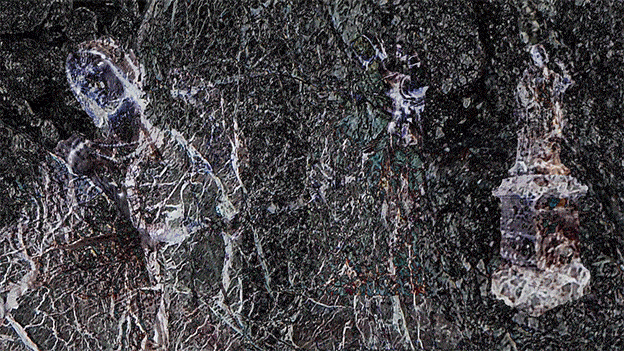Anastasia Manole
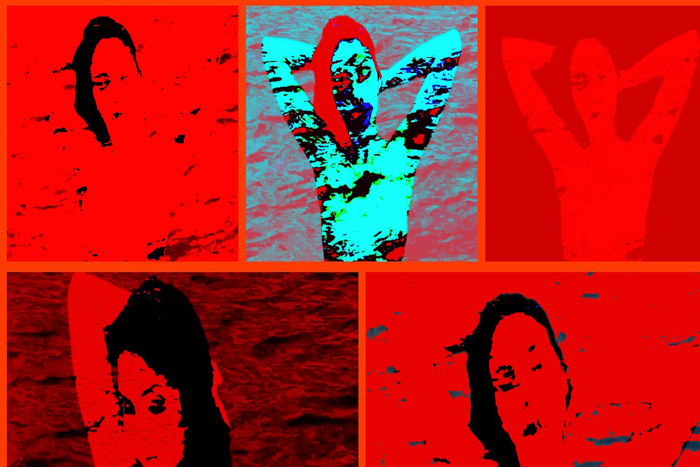
*Part of an Interview Series Taken by Sabin Borş in 2018
Anastasia Manole is the avatar created for her works online by Bucharest-based Gabriela Mateescu, a feminist artist who works with performance, video-performance, installation, and drawing. While Mateescu’s works tackle issues that have to do with the sociality of art and the constant exchange of information that keeps feeding collectives, the communication networks among her fellow artists as a growing work of art or an evolving system that has to do with people rather than stable or frozen objects—Anastasia Manole uses mostly stock images, Google-searched images or YouTube videos, relying on basic skills of montage and editing that remain deliberately sketchy and unfinished. These works provide a subjective commentary on how art has become again a craft that better imitates reality. Displaying a wide range of topics and themes rooted in self-referential exploration, Anastasia Manole shifts between spontaneous displays of feminism and remixable data.
Sabin Borş: Were there any influences in the way you started working with digital content and the Internet?
Anastasia Manole: I was influenced by my best friends Vlad Anghel and Tristan. I was just finishing my studies and did not have a studio to work or any motivation. I was working on my laptop non-stop and, under their influence, I just started playing with stock footage that I used in different job-related assignments. The selection then became more personal—but yes, just a lot of time spent online and lack of real space to work in. First, I started just mixing footages with self-portraits, playing with a psychedelic aesthetics, but afterwards, it grew into just another medium for expressing my ideas.
My main influences were my friends. I never had any initiative to find out more about digital art, I just treated it as a new and fun medium to play with. As I practiced, it became more serious, but I never used it as a way of questioning the medium—for me, it is a tool, a pen, an extension of my thoughts. I work 24/7 online, it’s only natural to use this virtual tool to express myself and it’s rare that I don’t look at a computer/smartphone screen. It is our duty as artists to respond to the contemporary. And it’s difficult for me at the moment to find time to draw, to sketch; I can’t say that I find relaxation in using traditional mediums. So how can I create using tools that have become so strange to me? It comes naturally for me to work as an artist from my own experience. My experience is now very closely related to the online. Maybe in 10 years it will change.
SB: Do you think there is anything particular about digital content that makes it more appealing than other media to express your ideas?
AM: I don’t, actually. I like all kind of mediums… I work with ideas that are self-referential. I started using the virtual tools because they expressed my situation in a certain period. I don’t consider myself only a digital artist; the medium does not define my practice, as it does for my other three colleagues and friends (Taietzel Ticalos, Tristan and Vlad Anghel).
SB: But are there any ideas or situations that you feel are more suitable to be presented in this format? Anything that ‘demands’ to be expressed digitally because it would be more in tune with its structure of expression? The question comes specifically because all your works are extremely personal and you are often directly involved in the artwork. In this respect, it is a very performative way of using digital media.
AM: Yes, I think the way I interact with the virtual world, the online platforms, the energy and emotions that are invested in the endless scrolling for information, is more suitable to be transformed into digital format. This is the reason why I decided to split my practice, beyond the self-referential bias—the fact that my reality changed gradually has made me look for different ways to respond to these alterations. It came naturally to me to work with the digital medium, since I spend 80% of my daily time online. The pencil and the brush were of no use anymore.
SB: You developed another persona, Anastasia Manole, for your digital works and you exhibit under both names, Gabriela Mateescu and Anastasia Manole. Why did you choose to delimitate your works like this? And which one (Gabriela Mateescu or Anastasia Manole) do you think is more successful?
AM: The avatar Anastasia Manole was created to serve as my Tinder profile. When I started doing my digital collages, I did not want to publish them under my real name because I considered them as visual experiments, I play around until I find my studio to work on my objects. I created a Tumblr and a New Hive account to upload works there. Back then, finding a studio to start working began to take longer and longer, so I started working with other mediums like video and performance in order to avoid finding reasons not to work. I was selected with some of my digital works, together with my friends, for an exhibition in San Francisco, I think, and then it struck me—that my digital works were actually becoming better because they were reflective of my state of mind, of me not choosing to procrastinate, to do art no matter the medium, the lack of time or the financial problems. I was not even aware of the digital scene, I didn’t even do any research on this matter; for me, it was just a more accessible medium to create with. I did not seek to be assimilated by any digital art wave or post-Internet—everything happened naturally and authentically. I still work in parallel with my two personas, it is fun: Anastasia is more playful, she gives me more freedom, while Gabriela is more personal and socially engaged.
SB: How do you translate your work from the screen to the physical space?
AM: I take into consideration the technical possibilities and the space. Until now, I was my own curator and I was satisfied with the result. I prefer working with video installations more than printing my work, it gives them context and I like to play with the space. When I worked with a gallery the pressure of printing was big, to create objects that can be sold. Now I have my prints and my friends’ works in my apartment, some were just too big to transport, because the gallery wanted them big. It was a not a very satisfactory situation so I decided not to put myself in that position again. I don`t want to waste any materials to produce my works if there will be thrown away after the exhibition. My apartment is full of my art and my friends’ art, I cannot transport it to a deposit when my art can be easily translated in ephemeral mediums. I will think about working with physical objects when I will be sure that my works can be viewed after the end of an exhibition by one or more people and will not be stored. I often gift my works to my friends. I consider it a waste to not be enjoyed.
SB: Do you feel printed works may lack the context or an expressive power when it comes to works created using video or digital media?
AM: No, I don’t. I think every work has to follow the artist’s intentions. I see ads all day online and then their prints on the streets, in shops and magazines… So transposing one medium into another doesn`t change its power for the viewer. I think of it more in terms of the alteration of thought and intention done under the pressures exerted by commercial galleries or art fairs—or the entire art world per se.
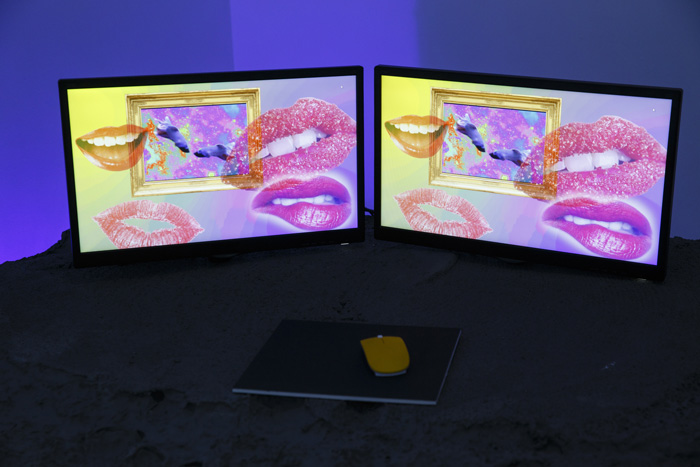
SB: Which of your artworks do you think is more representative?
AM: All of them. They represent certain stages in my life and they can be either bad or good, they were my artistic expression in one determined period of time.
SB: How much is ‘digital art’ in general is encouraged in art schools in Romania?
AM: The concept of ‘digital art’ is not even present in the universities of art, not to mention in schools. The consequences are reflected in the local scene: there is a total lack of any critical take on this medium; artists rarely use it because they fear it is too superficial; there are no professors, theoreticians, or historians to present these possibilities to young students—and they are left to discover by themselves, which usually takes longer.
There is a new Master’s program in English at UNATC: Interactive Technology for Performing and Media Arts that focuses on new technologies and software. There are just 5 available positions and the taxes are high, but considering the access to the newest technology and the classes it is worth it. Otherwise, in neither of the universities of arts in Romania has there been anything similar introduced or even mentioned. All the initiatives are done by different cultural organizations (like ours).
SB: Do you think this also has to do with the fact that painting and other traditional mediums—but painting, most evidently—has been privileged both in terms of discourse and in terms of its ‘marketability’? Or with the fact that there is a more general lack of understanding of the conceptual aspects of technology in general?
AM: Of course; traditional museums had had hundreds of years to accommodate to the collective mindset. A 30 years old medium does not have the tools to compete with something that has already established its status in museums and other forms of cultural goods preservation.
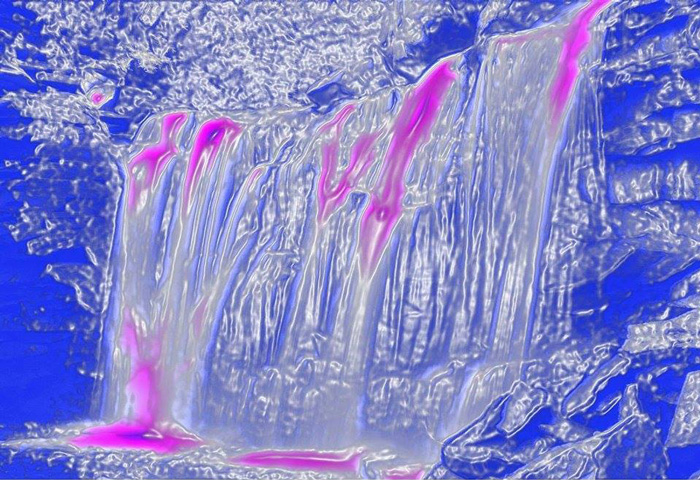
SB: What about the support from art galleries, or institutions, or private collectors… Did you find any for your work? Do such organizations understand the specificities of working with digital content?
AM: Never for my digital works. I had one group show with a commercial gallery, four years ago I think (with Suprainfinit Gallery in Bucharest). After that I collaborated only with project spaces, where it is easier to exhibit your ideas but, of course, without having access to collectors or any commercial gain.
I think it’s easier to work with institutions and project spaces because the freedom that you have is larger than with private galleries, which want you to produce objects that they can trade. I understand, there is no interest from the collectors, and galleries have to support themselves. But I don’t have hopes of getting remuneration for my art in the next years. All my colleagues have side-jobs to sustain their production, it’s a slippery road and a lot of them just quit in the process.
SB: Commercial galleries might have a tough time supporting digital creation because there are no collectors or institutions exploring this area, it’s true. They don’t have anyone to sell the works to, unless they themselves access various institutional funding programs or rely on selling the works at various fairs, mostly outside Romania. So maybe the real issue is trying to conceive institutional programs and structures that could support the artistic endeavor on a more continuous basis. culture?
AM: I believe that the only way to get financial support for new media arts is an institutional matter now and investment in education of the future generations that need to understand that art is also as accessible as a Gucci bag. The millennials are the target for the new market. The tricky thing is to get to the public that spends the same amount of money on useless things, to reach out to them, to convince them that art is worth having around the house. If collectors only collect Basquiat or the 100th copy of a Warhol serigraphy, then they can be educated by new and relatable artists.
SB: You said you don’t have hopes of getting remuneration for your digital work… But how about international opportunities or online platforms that allow artists to sell their works directly? How much did you explore this possibility—to bypass the commercial gallery and sell directly using online services?
AM: Not really, I was and am more concerned with the local scene. I usually work with my local network of artists, curators, and galleries. I used different platforms for showcasing digital art, but the process of applying is very ‘bureaucratic:’ you need to have a good CV, where you need to have good exhibitions, portfolios with good documentation of your exhibitions, recommendation letters, and the refusal at the end of this action can affect people’s self-esteem, including mine. I prefer to let it grow more organically, take care of my works, be visible, encounter people.
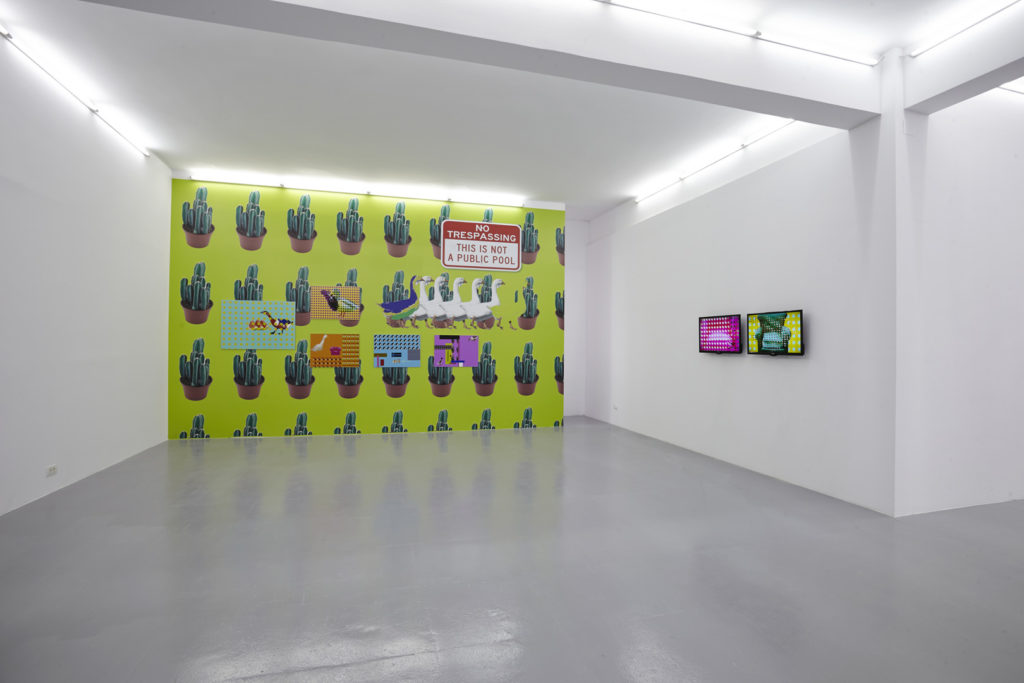
SB: Could you please tell us more about the project you did at Suprainfinit? How did you see it in relation with the works of the other artists, given you do not consider yourself to be primarily a digital artist?
AM: The exhibition at Suprainfinit wanted to be a fresh start with young artists who were crazy and not into the market world. Suzana [Vasilescu, the founder of the gallery] had the bravery to engage into promoting young, new and interesting artists. For us, it was a nice experience because we were all friends and had big dreams. But the exhibition was not focused on digital artists, it was rather focused on new technologies, our community being a more special target. Alexandra Terzi did a nice installation mapping a dinner table with emoji, and another colleague of ours, Alina Anca, had a really nice interactive installation where you could touch some flowers and different lights would appear. Tristan, Vlad Anghel, Taietzel and I had a more close relation and I was also in charge of producing all the works for them, because it was the first time we had money to actually print our works and go crazy. And it was the last time to this day. We never had after that another paid opportunity to just do whatever we wanted. We mostly send our works via YouTube, Vimeo, Wetransfer and exhibit on screens, tablets or projectors.
SB: In 2014 you started the group Nucleu 0000 and, as a curator, you often exhibited and encouraged artists working in the digital field. How would you describe your approach to curating digital works?
AM: Actually, the group focuses only on multi-media works. It also is connected to my interests as artist and curator, and the fact that it is difficult for multi-media artists find spaces to work with and exhibit their work. Traditional mediums are better represented in the local scene and find more openness from the galleries. Promoting Romanian digital art/ists, showcasing women artists and giving opportunities for artists that work jobs unrelated to the cultural field were the main priorities. Now the platform spamindex.com is a materialization of one of these causes. We tried to create a proper platform for digital, net, post-internet art to be exhibited and also financially aid the artists.
SB: You place emphasis on the idea of teaching, of passing on information or knowledge or the craft. You also taught visual communications for some years, which certainly reflects the importance of mediation and communication in your work. If you were to start an education program in Romania in media arts more generally, what are the most important aspects new students should learn first? What is it that defines digital content—is it technology, its underlying concepts, experimentation, awareness of cultural and social situations…?
AM: I think this is a paradox—all the young people who are now using technology almost full-time, are still skeptical when it comes to digital art and new media arts; they seem to attribute less value to it than they do to painting or sculpture. As I said, this is a matter of getting accustomed to the collective mindset. Technology has been here for less time that it would take to already be fully assimilated. Dada, Futurism, action and abstract painting too were also looked at suspiciously during their lifespan. I think we need to include contemporary art in the public school curricula. People need to take their children to contemporary art galleries. We spend so much money on things we never use, but we are not educated in spending money on arts; it doesn’t have to be a lot of money either. So, the most important aspect is the proximity to art itself—to see that it is validated by other people as well. In the era of social media influence that represents today’s market values, we see the need to validate products more than ever. Companies that were big in the 90s’ and 2000s’ are now left behind because their buyers all seek to buy products that are endorsed by other people. So yes, art is nowhere on the horizon for these people—and to create proximity with contemporary art starting from a young age is, in my opinion, the most important factor in education. They need to see that art is relatable to them.
The Romantic Women, Anastasia Manole
SB: Feminism seems to be a largely marginal topic of serious or engaged discussion in Romanian art, in spite of an incredible number of good female artists, various initiatives, and some studies that have been published in the past years. There continues to be a profound ‘patriarchal’ cultural complex that does not accommodate openly feminist, LGBT or queer sensibilities so easily, if at all. How do you see this issue, as a feminist artist, and what do you think should change? Also… female digital artists have been at the forefront of cultural changes elsewhere, with women and/in technology a particular strong point lately. Do you think the initiatives you are part of can help create the premises for a change in attitude and perhaps open new possibilities for young female artists working with digital media?
AM: I was part of a group of local artists from Bucharest for two years and we called ourselves Local Goddesses. We coordinated a space dedicated to women artists working with new media, but we separated, each one of us going our own way. I think in Bucharest there is a serious community that engages with topics such as feminism, women’s and LGBT rights. For me, on a personal level, I really dislike the fact that it is an ‘ISM’. For me, it’s common sense—but it seems to be less obvious for many people, hence the need to put it more evidently in my bio. I try to help other women artists, the shows I coordinate are often women only shows and include LGBT artists. In my practice, I usually deal with the problems I confront, that are embedded of course in problems that all women have. But I repeat, for me the feminist manifesto is about common sense; I would rather not use this word in my practice but unfortunately, it’s still necessary.
SB: Do you think digital visual culture has changed in any way significant over the past few years?
AM: Actually, I think that the art world has less interest for digital art. I see art fairs, weekend galleries, digital art is nowhere to be found, just in specific centers dedicated to this medium. Not necessarily in Romania, but also foreign galleries are just not interested in digital artists and the art media has no interest in promoting it.
SB: So why do you think this happens? Does the art world return to the traditional medium (it never left it, of course) or do you think there are other shifts taking place in the art world and in culture more generally?
AM: I think we live in a world where anyone can be an artist, whether it’s online or in the real world. What is lacking is art comprehension. From the art fairs’ and art galleries’ perspective, I can understand that it’s all just a matter of business, we cannot expect them to go bankrupt. It is the responsibility of the educational and cultural system to create spaces, festivals, events where artists are supported financially, so that they have a platform to help them communicate with the public.
Anastasia Manole (Gabriela Mateescu) graduated the Graphics Department at the National University of Arts in Bucharest and taught visual communications at the National University of Arts from 2013 to 2016. For one year she was the program coordinator of the Center of Visual Arts, a multimedia center in Bucharest (2014-2015), alongside Taietzel Ticalos. Together, they managed an artist-run space dedicated to promoting students and young graduates of arts faculties, proposing a series of reflections that question the situation of the young generation of artists and their positioning on the local art scene. This space was a materialization of the project Nucleu 0000 that started in the same year and has been running ever since. In 2015, Mateescu started working with a local support group of women artists, Local Goddesses, after the cultural space Platforma—National Museum of Contemporary Art Annex was dissolved. They took the project to the Center for Visual Arts, a space owned by the Union of Artists in Romania, for a collaborative curatorial project, showcasing multimedia women artists.
She is the co-founder of the platform spamindex.com.
Sabin Borș (b. 1981) is an independent editor and curator who also works as freelance layout designer for various web and print cultural projects. He is the founder and editor of the anti-utopias.com contemporary art platform and has been working for various specialised print and online media outlets in the field of art and architecture since 2009. In parallel with his Ph.D. thesis in philosophy—tackling the subject of archives, discourse, and contemporaneity—he started developing a multi-modal archival installation. The installation is intended as a critical approach to constructing cross-cultural and cross-disciplinary frameworks for the documentation, interpretation, and dissemination of contemporary art, providing alternative understandings of the socio-political foundations of art, constituent cultural differences and transitions, or superposed cultural, scientific, and technological interactions. He takes particular interest in dialogical constructions that create divergent networks of meaning between mediums, disciplines, and practices.
